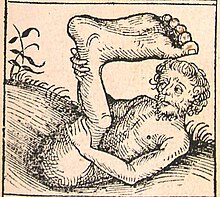Ctesias
Ctesias (
Historical events

Ctesias, who lived in the fifth century BC, was physician to the Achaemenid king,
Ctesias was the author of treatises on rivers and on the Persian revenues as well as an account of India entitled
Persica
The first six books of Persica covered the history of Assyria and
According to the
Indica

A record of the view that the Persians held of India was written by Ctesias under the title Indica. It includes descriptions of artisans, philosophers, and people having the qualities of deities, as well as accounts of unquantifiable gold, among other riches and wonders.[7] The work is of value as it records the beliefs of the Persians about India.[1] The book only remains in fragments and in reports made about the book by later authors.
References
- ^ a b c d One or more of the preceding sentences incorporates text from a publication now in the public domain: Chisholm, Hugh, ed. (1911). "Ctesias". Encyclopædia Britannica. Vol. 7 (11th ed.). Cambridge University Press. p. 594.
- ISBN 9788323388197.
- ISBN 9788323388197.
- ^ Peter Frederick Barker, From The Scamander To Syracuse, Studies In Ancient Logistics, page 9, chapter 1.
- ^ Lucian, A True Story, 2.31
- ^ "Persepolis". Encyclopedia Britannica. 30 October 2023.
- ISBN 978-0-06-087414-8.
Further reading
- Ed., trad. et commentaire par Dominique Lenfant, Ctésias de Cnide. La Perse. L'Inde. Autres fragments, ISBN 2251005188).
- Schmitt, Rüdiger (1993). "CTESIAS". Encyclopaedia Iranica, Vol. VI, Fasc. 4. pp. 441–446.
- Jan P. Stronk: Ctesias' Persian History. Part I: Introduction, Text, and Translation, Wellem Verlag, Düsseldorf, 2010 (ISBN 9783941820012).
- Andrew G. Nichols, Ctesias: On India. Translation and Commentary, Duckworth, 2011, ISBN 1-85399-742-0
- Lloyd Llewellyn-Jones and James Robson, Ctesias' History of Persia: Tales of the Orient, Oxford, 2010 (ISBN 9780415364119).
External links
- Ctesias of Cnidus
- Overview of all fragments of the Persica and Indica by Jona Lendering
- Photius' Excerpt of Ctesias' Persica translated by J. H. Freese (1920)
- Photius' Excerpt of Ctesias' Indica translated by J.H. Freese (1920)
- Greek text (Müller 1858)
- Texts of Ctesias
